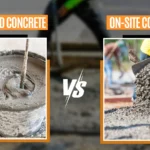Are you struggling to remove paint from your concrete surfaces? Accidents happen, and paint spills can be a common occurrence. Removing paint from concrete can be a challenging and time-consuming task, but it’s not impossible. Luckily, understanding how to get paint off concrete without damaging the surface is the key.
If you’re tackling this task, you’ll need to consider factors like the type of paint, the age of the stain, and the condition of the concrete. A fresh spill requires a different approach compared to years-old dried-up paint. Below, we’ll break down the best methods for removing paint and provide step-by-step guidance to ensure a smooth concrete cleaning process.
How to Remove Paint from Concrete?
- Identify the type of paint on the concrete.
- Choose the right method: chemical strippers, pressure washing, sandblasting, or grinding.
- Prepare the area, apply the method, clean up, and prevent future paint spills.
A Step-by-Step Guide: How to Clean Paint Off Concrete?
1. Identify the Type of Paint on the Concrete
Before starting the removal process, it’s crucial to identify the type of paint on the concrete surface. Different types of paint require different removal methods, and using the wrong method can damage the concrete surface.
To identify the type of paint, you can perform a simple test. Apply a small amount of rubbing alcohol or paint thinner to a small area of the painted surface. If the paint dissolves, it’s likely latex paint. If it doesn’t dissolve, it’s probably oil-based paint. Epoxy paint is more challenging to remove and may require professional assistance.
Check out this blog: How to drill into concrete?
2. Choose the Best Removal Method
There are several techniques for concrete cleaning, each suited for different levels of paint removal.
-
Chemical Strippers for Tough Paint Stains
Chemical strippers break down the bond between the paint and concrete, making it easier to remove. They are effective for stubborn, oil-based paints and large areas. However, they require safety precautions.
How to Use Chemical Strippers:
- Choose a paint stripper designed for concrete surfaces.
- Apply the solution evenly over the paint.
- Let it sit for the recommended time (usually 30 minutes to a few hours).
- Scrape off the loosened paint using a scraper or wire brush.
- Rinse thoroughly to remove any remaining residue.
Safety Tip: Always wear gloves, goggles, and a respirator when handling chemical strippers, and work in a well-ventilated area.
Check out this blog: How to lay a concrete base?
-
Pressure Washing for Large Areas
Pressure washing is an effective way to clean paint off concrete, especially for driveways, sidewalks, and patios. It blasts away paint using high-pressure water.
Steps for Pressure Washing:
- Cover nearby plants and furniture to prevent damage.
- Use a pressure washer with at least 2500-3000 PSI.
- Hold the nozzle at least one foot away from the surface.
- Spray in a sweeping motion to avoid damaging the concrete.
Pro-Max Tip: Use a concrete-safe detergent for better results if the paint is stubborn.
-
Sandblasting for Deeply Embedded Paint
Sandblasting is an aggressive removal method that uses high-pressure air to blast abrasive materials onto the surface, stripping away the paint. It’s ideal for industrial or commercial concrete cleaning, but can damage concrete if done incorrectly.
How to Use Sandblasting:
- Protect nearby areas from abrasive particles.
- Wear full protective gear (gloves, goggles, and a respirator).
- Use sandblasting equipment to remove the paint layer by layer.
Warning: Sandblasting is best left to professionals, as it can damage the concrete surface if misused.
-
Grinding for Large or Thick Paint Layers
Grinding uses a machine with a rotating disc to scrape away layers of paint. It’s an excellent choice for thick paint coatings or large areas.
How to Grind Paint Off Concrete:
- Cover the surrounding areas to prevent dust spread.
- Wear protective gear, including a mask and goggles.
- Use an industrial grinder to slowly grind the paint off in sections.
- Vacuum or sweep up dust after grinding.
Best For: Industrial floors, garages, or large outdoor surfaces.
Check out this blog: Types of Concrete Grade, Their Uses and Strengths
-
Scraping and Wire Brushing for Small Stains
For smaller paint spots, a paint scraper or wire brush can manually lift the paint.
Steps for Scraping Paint Off Concrete:
- Soften the paint with hot water or a mild chemical stripper.
- Use a scraper or wire brush to remove as much paint as possible.
- Vacuum or sweep debris to clean the area.
This method works well for minor paint stains but can be time-consuming for larger areas.
-
Absorbing Oil-Based Paint with Cat Litter
For fresh oil-based paint spills, cat litter can absorb excess paint before removal.
Steps to Absorb and Remove Oil-Based Paint:
- Sprinkle cat litter over the spill and let it sit for a few hours.
- Sweep it up and dispose of it properly.
- Follow up with a paint stripper to remove any remaining stains.
This method is particularly useful for garage or workshop floors.
Common Questions About Paint Removal from Concrete
|
Question |
Answer |
|
How Long Does it Take to Remove Paint from Concrete? |
The time it takes to remove paint from concrete depends on the type of paint and the chosen removal method. Chemical strippers may take several applications over several hours, while pressure washing may take several passes. |
|
Can You Paint Over the Concrete After Removing Paint? |
Yes, you can paint over concrete after removing the paint. However, it’s essential to prepare the surface properly before painting. This includes cleaning the surface and allowing it to dry completely before applying the new paint. |
|
What are the Risks of Removing Paint from Concrete? |
The risks of removing paint from concrete include damaging the concrete surface, exposure to harmful chemicals, and injury from equipment. Always take safety precautions and follow the instructions carefully. |
|
How Much Does it Cost to Remove Paint from Concrete? |
The cost of removing paint from concrete depends on the size of the area, the type of paint, and the chosen removal method. Chemical strippers and pressure washing are generally less expensive than sandblasting and grinding. |
Check out this blog: What is concrete made of?
3. Prepare the Area
Before starting the removal process, it’s essential to prepare the area. Cover nearby plants and furniture to protect them from the removal method, wear protective gear, and ensure proper ventilation. Proper preparation can prevent damage to nearby items and protect your health.
4. Apply the Chosen Method
After choosing the best removal method and preparing the area, it’s time to apply the method. Follow the step-by-step instructions for the chosen method, and use the tips for safe and effective removal.
5. Clean Up
After removing the paint, it’s crucial to clean it up properly. Dispose of leftover materials and clean the surface of the concrete. Proper clean-up can prevent damage to the environment and ensure a clean surface for future use.
Check out this blog: How long does concrete take to set?
6. Prevent Future Paint Spills
Preventing future paint spills can save time and money. Some ways to prevent future paint spills include using protective coverings, being more careful when painting, and cleaning up any spills immediately. Prevention is always better than a cure.
Personal Case Study: Removing Paint from My Garage Floor
A few months ago, I faced a frustrating challenge: getting rid of old, peeling paint from my garage floor. The previous homeowner had marked parking spaces with oil-based paint, but years of wear and tear had left it chipped and faded. The messy, uneven patches made the space look neglected, so I decided it was time for a refresh.
After researching how to get paint off concrete, I discovered that using a chemical stripper would be the most effective method for my situation. I took all necessary precautions like wearing gloves, goggles, and a mask to protect myself from fumes before applying the stripper to the affected areas. The instructions recommended letting it sit for a while, so I waited patiently before scrubbing the surface with a wire brush.
As I worked, I could see the paint breaking down and lifting off the concrete surface. It took a few rounds of scrubbing, but eventually, the garage floor was free from the old markings. I followed up with a thorough wash and proper disposal of any residue, leaving the space looking clean and refreshed.
This experience taught me the importance of choosing the right method for how to clean paint off concrete. Identifying the type of paint and using the correct removal technique made the process smoother and more efficient. Now, my garage looks as good as new, proving that with the right approach, anyone can restore their concrete surfaces with ease.
Check out this blog: Pouring concrete in hot weather
Bottom Line
Removing paint from concrete can be a challenging task, but by applying the method carefully and cleaning up properly, you can successfully remove paint from concrete surfaces. Additionally, preventing future paint spills can save time and money. Remember to take safety precautions and follow the instructions carefully to prevent damage to the concrete surface and protect your health.
At Pro-Mix Concrete, we provide high-quality concrete mixes tailored for repairs, resurfacing, and new installations, ensuring a long-lasting and polished finish. Plus, with our expert guidance and top-tier ready mix concrete solutions, you’ll get professional results every time.
Need expert advice or top-grade materials? Pro Mix Concrete has you covered. Call us today and give your concrete the upgrade it deserves!
Check out this blog: How to mix concrete?
Frequently Asked Questions
The best way to remove paint from concrete depends on the type of paint and surface condition. Common methods include using chemical strippers, pressure washing, sandblasting, or grinding. Each method requires proper safety measures and may take multiple applications for complete removal.
If you plan to repaint the surface, priming is recommended. After removing the paint, clean the concrete thoroughly and let it dry. A quality primer helps the new paint adhere properly and provides a more durable finish.
Some removal methods, like aggressive grinding or high-pressure washing, can weaken the concrete if not done correctly. Chemical strippers, if overused, may alter the surface texture. Always follow the right techniques to minimise damage.
The cost depends on the paint type, surface size, and method used. DIY options like chemical strippers or pressure washing typically range from $20 to $150. If you hire professionals for sandblasting or grinding, expect to pay between $300 and $1,000.
Author Profile
- Admin
Latest entries
BlogJune 27, 2025How Same-Day Concrete Delivery Works in the UK?
BlogJune 26, 2025Pre-Mixed Concrete vs. On-Site Concrete Mix
BlogJune 24, 2025Affordable Concrete Supplier in London
BlogJune 22, 2025Concrete Pumping Services: When and Why You Might Need One




